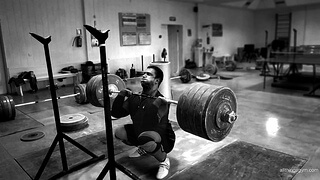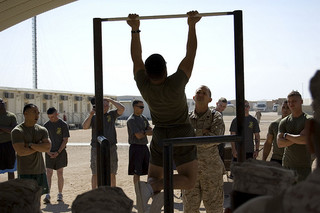Everything works but only for a limited time. The human body is amazing at adapting, this is why a beginner new to lifting makes loads of progress in the beginning simply by showing up and the same reason they stagnate three months later.
If the body doesn't need to adapt it will not and therefore will never get bigger, stronger or faster beyond a certain point. As we know the body adapts to the stresses imposed upon it, so it makes sense that a novice lifter will quickly gain strength with any type of strength program. The reason is simple, they are introducing a brand new stress which is causing the body to adapt, but in a few months the body has adapted and can easily handle that stress and has no reason to adapt any further. Most people are familiar with this idea and concept but don't really understand how to apply it over the long run.

What is progressive overload?
Before we discuss the potential methods of using progressive overload it is important to understand a few key ideas. The first is that progressive overload will not be linear over the long-haul but more wave like. If progress was always linear we would be lifting cars and outrunning cheetahs for the fun of it. Even when progressive overload is applied appropriately progress isn't always quantitative meaning it isn't always reflected by changes in the numbers during your training sessions. The stronger and more experienced you become the more evident this becomes. This is normal and shouldn't discourage you from continuing on. If you are a beginner then expect your strength gains to be at there all time best your first three months of training. Each week you will get stronger and easily beat past personal records. This is mostly due to the bodies improvements in intermuscular coordination. Enjoy it while it lasts because your rate of gain will significantly slow down after your "newbie" stage.
Secondly, the amount and type of progressive overload applied should always be dictated by technical proficiency. This is the first, most important and most overlooked variance. If you cannot perform an exercise with technical and biomechanical proficiency then optimal efficiency is not possible. If movement is not efficient durability is limited in addition to a higher energy demand per unit of time. Simply meaning, the more proficient I am technically performing an exercise the less energy it requires metabolically which makes it more efficient. The more efficient I move the less overall energy I require to complete any given task, which leaves more fuel in the tank for future sets and/or exercises and make me more durable and resistant to wearing out or breaking down.
The third consideration before deciding how to utilize progressive overload in your training is that the complexity and variances of progressive overload is dependent on your training age and strength levels. Don't get fancy just to get fancy; don't "change it up" for the heck of it. Stick to a simple method of progressive overload as long as you can and when it stops working change it, it's really that simple.
- Lifting the same amount and volume with better form, more, control and less effort (efficiency)
- Lifting heavier loads (intensity)
- Lifting the same load for more reps (volume)
- Lifting the same load for more sets (volume)
- Doing the same work in less amount of time (density)
- Lifting the same load and volume with less rest time in between sets (density)
- Lifting the same load and volume with less rest time in between sets (density)
- Doing more sets with the same load and reps (volume) Lifting the same load and volume more often throughout the week (frequency)
How to simply implement progressive overload:
- Become technically proficient at the movement by learning the exercise in and out, identifying the purpose and what it should feel and look like. Understand where you tend to have technical breakdowns in the movement so you will have good awareness of your positioning even during fatigue.
- Add weight to the movement maintaining technique at all costs. Choose a given set and rep scheme (3x10, 3x8, 3x5) at a weight you can easily handle.
- The next time you perform that exercise add more weight to the bar (5-10 pounds) and attempt to perform same sets and reps as the previous session.
- Next time use the same reps and weight as the last session but add another set.
- Next time use the same sets and weight as last session but increase the reps.
- Next time start back at step two and work your way down again, if you are fatigued then introduce a deload week and if you are changing the exercise begin at step one again.
Example:
Select an exercise: Back squat
- Work on squatting mechanics inside and out with the bar only.
- Work-up to a weight where you can perform 3 sets of 6 reps @ 100 pounds
- Perform 3 sets of 6 reps @ 105 pounds
- Perform 4 sets of 6 reps @ 105 pounds
- Perform 4 sets of 8 reps @ 105 pounds
- Perform 3 sets of 6 reps @ 110 pounds
If you stagnate during any of the steps and struggle, which will happen eventually, reassess your form to make sure it isn't a technical issue. If you believe you technique isn't your limiting factor, take note of your energy levels. If you feel a little beat up and run down you are probably due for a deload week. During this week reduce weights and overall training volume by 50% and come back the next week and get at it again. If you feel your technique and energy is good to go then it's time to make an adjustment in your methodology. Typically I recommend changing up the set and rep scheme. So if you were performing the bench press the past few weeks for 3-4 sets of 6-8 reps change the loading scheme to 3-4 sets of 4-6 reps.
"If it doesn't challenge you it doesn't change you."

photo credit: Gregor Winter via photopin ccphoto credit: Patrick the Smith via photopin cc photo credit: <a href="https://www.flickr.com/photos/doodle_m/5995328046/">Alastair Montgomery</a> via <a href="http://photopin.com">photopin</a> <a href="http://creativecommons.org/licenses/by-nc-nd/2.0/">cc</a>

